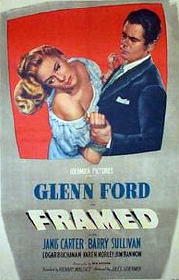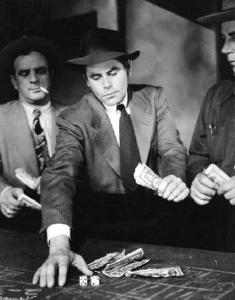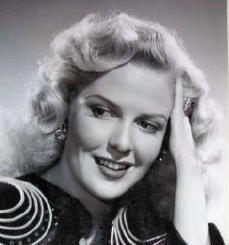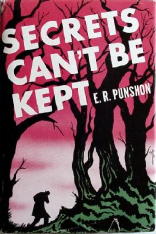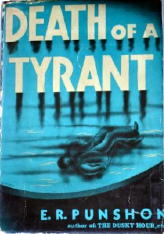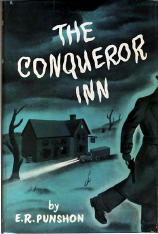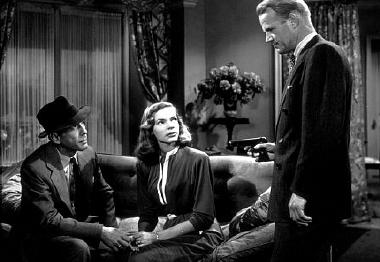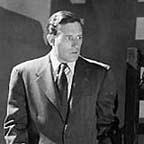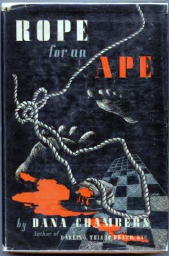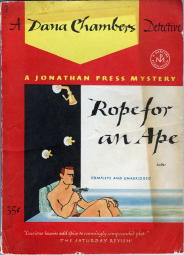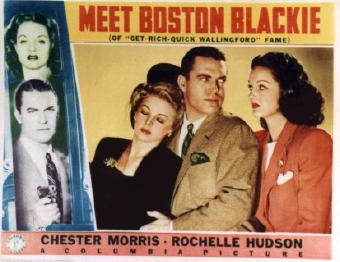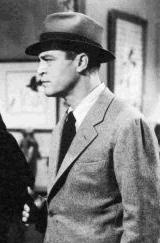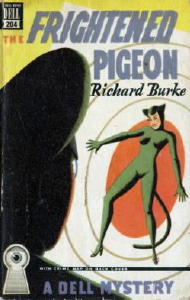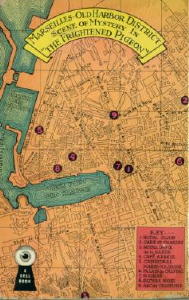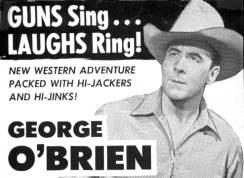DANA CHAMBERS – Rope for an Ape
Jonathan Press Mystery J63; digest-sized paperback; no date stated, but circa 1951. Hardcover edition: The Dial Press, 1947. Previous paperback edition: Bestseller Mystery B-103; abridged; no date stated, but circa 1948.
Jonathan Press and Bestseller Mysteries were each published by the same company, which was essentially Mercury Press, with Lawrence E. Spivak the actual publisher. Back in the 1940s Mercury Press also published Ellery Queen’s Mystery Magazine, to set a frame of reference, perhaps. I have no idea why this particular book by Dana Chambers was so popular that they did it twice. The books they reprinted are not considered very collectible, since more often than not, many of them were abridged. In this case I read the uncondensed version, and I’m sure I’m far better off for having done so.
Since Dana Chambers is all but a brand new author for me, you’ll have to indulge me. Let me check in with Al Hubin’s Crime Fiction IV to see what other mysteries he might have written:
CHAMBERS, DANA; pseudonym of Albert Leffingwell, (1895-1966); other pseudonym Giles Jackson
* Some Day I’ll Kill You (n.) Dial 1939 [Jim Steele; Connecticut]
* Too Like the Lightning (n.) Dial 1939 [Jim Steele; New York City, NY]
* She’ll Be Dead by Morning (n.) Dial 1940 [Jim Steele; New York City, NY]
* The Blonde Died First (n.) Dial 1941 [Jim Steele; Ship]
* The Frightened Man (n.) Dial 1942 [Jim Steele; New York City, NY]
* The Last Secret (n.) Dial 1943 [Jim Steele; New York City, NY]
* Darling, This Is Death (n.) Dial 1945 [Miami, FL]
* The Case of Caroline Animus (n.) Dial 1946 [Jim Steele; Miami, FL]
* Death Against Venus (n.) Dial 1946 [New York]
* Rope for an Ape (n.) Dial 1947 [New York]
—
** Dear, Dead Woman (n.) Jonathan Press 1948; See: The Case of Caroline Animus (Dial 1946).
** Too Like the Dead (n.) Bestseller 1951; See: Too Like the Lightning (Dial 1939).
** Blood on the Blonde (n.) Jonathan Press 1952; See: Witch’s Moon (Dial 1941), as by Giles Jackson.
LEFFINGWELL, ALBERT (1895-1946); see pseudonyms Dana Chambers & Giles Jackson
* Nine Against New York (n.) Holt 1941 [New York City, NY]
JACKSON, GILES; pseudonym of Albert Leffingwell, (1895-1946); other pseudonym Dana Chambers
* Witch’s Moon (n.) Dial 1941 [Nile Boyd; Connecticut]
* Court of Shadows (n.) Dial 1943 [Nile Boyd; New York City, NY]
There’s a year of death discrepancy there, I see, but I suspect that 1966 is the one that’s wrong, and that it was really 1946 when he died. If so, that would mean both that Leffingwell died young and that the book in hand was published posthumously. If and when I learn more, I’ll let you know.
While I have some of the books listed above, I’m almost positive that Rope for an Ape is the first one of them I’ve read. As for who Jim Steele was, I admit I have to cheat and tell you what Bill Crider had to say about him on his blog, where he recently reviewed The Blonde Died First:
You don’t hear much about Dana Chambers these days. In fact, you don’t hear anything at all, and Chambers isn’t mentioned in any of the reference books I have handy. But in the 1940s, Chambers was a prolific and well-reviewed writer of medium-boiled mysteries.
The Blonde Died First is narrated in the first person by Jim Steele, who’s supposedly a successful script writer for radio, though we just have to take his word for it. There’s nothing in the novel to prove it.
Steele is a series character, and this isn’t his first appearance. I gather that he was a pretty successful spy at one time since he has the Medal of Honor. But in this one, he’s just a guy trying to solve a couple of murders, including that of the blonde of the title. (The title, by the way, is a clue.) Most of the book takes place on a cruise ship, and there’s quite a bit of action, a complicated plot, and Steele’s smooth narration to carry you along. Things get really kinky by the end of the book, surprisingly so, I thought, for a novel published in the 40s, but maybe I’m just naive. I have a couple of other books by Dana Chambers, and I guess it’s time I read them.
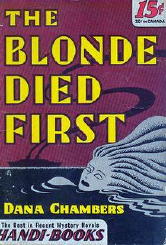
So Jim Steele is a radio writer, is he? Then what’s he doing being listed on Kevin Burton Smith’s master list of private detectives on his Thrilling Detective website? Acting like a PI in all his stories, as a wild and probably not-so-far-off-the-mark guess.
Jim Steele’s not in this one. Suffice it to say for now that the detective of record is a fellow named Nile Boyd, he has a girl friend named Anna Warriner, and I’ll say more about both of them more in a minute. First, though, what caught my eye was a short sentence on page 65 of this edition to the effect that he and Anne were involved in a case very much like this one “up in Connecticut a while back.” Aha! Here’s a series character appearance that Al Hubin didn’t know about before – see the pair of books written by Chambers as by Giles Jackson listed up there not too long ago.
Boyd works for the New York Clarion, and now that the war has ended, he’s back from overseas as a war correspondent. Anne, who works for the same newspaper, is nearly twenty years younger than he, and since he’s now on the East Coast and she’s in California visiting her mother, and maybe having a good time out there as well, he’s beginning to worry about how strong the attraction he has on her may actually be.
He needn’t worry too much, only just a little, as it turns out. As far as the detective puzzle is concerned, the one that Boyd soon finds himself in the middle of, this is one of those wealthy “upper crust affairs” that are the equivalent of the British manor house mysteries that were so common back in the 1920s, 30s and 40s. A well-to-do family is hosting a slew of guests over a long weekend, the only problem being that some of them starting to turn up dead.
The chief suspect, and a huge negative as far as I was concerned, is a giant ape who has recently escaped from a circus train which derailed nearby. Forget that. I’ve heard too many bad radio shows and watched too many equally bad B-movies that’ve been based on this same old plot gimmick, which was tired and worn out even the first time.
But the killer is all too human, as it turns out, and it takes all of Nile Boyd’s ingenuity to nab him. And all the while he’s doing so, with Anne’s assistance eventually, there is plenty of witty upscale dialogue to keep the reader amused on a fulltime basis – at least this one was – and as usual in novels like this, particularly in the beginning, everyone is drunk, was drunk or is about to get drunk. Well, yes, perhaps I am exaggerating, but maybe that’s because I am getting a little high on the fumes myself. (Never touch the stuff otherwise.)
The case eventually turns to the tough, though, what with guns and blows to the head (Boyd’s) and a small amount of generally restrained violence such as that. After the second murder, it begins to dawn on everyone that they’re not playing fun and games any more. Nonetheless, this is a fairly-clued detective puzzle, with a long explanation at the end, with all of usual trappings.
Something for everyone, you might say. An unusual mix, and maybe the book suffers a little for it, but if you ever come across a used copy and want my advice, I think you might take at least a second scan through it before saying Yay or Nay.
[UPDATE] 04-18-07. S. B. has asked me about the cover of the paperback edition. “Is that what I think I see?” Yes, indeed. If you think you see a man sitting in a bathtub with a gun in his hand, that it is exactly what it is. Is the scene in the book? Yes, indeed again. What you see is what you get.
[UPDATE] Later on 04-18-07. I’ve just received a pair of email messages from Victor Berch, who says in the first one:
Steve:
Just read your piece on Leffingwell. His middle name was Fear, which was his mother’s maiden name. He was born in Cambridge, MA, so I could check the Mass. Vital Statistics. On his draft card,the transcribers have transcribed his middle name as Fern, but looking at the actual handwriting, it is definitely Fear that is handwritten.
Victor
The second is a copy of Leffingwell’s obituary notice taken from The New York Times for August 15, 1946, so the year of death stated for him as Dana Chambers is the one that’s wrong, as suspected. Leffingwell, aged 51, was a former advertising executive who lived in Scarsdale NY at the time of his death, which occurred after a few months’ illness. He founded his own advertising agency, Olmstead, Perrin & Leffinwell, in 1925, the Times goes on to say, before turning to writing. It isn’t clear from the obituary whether he was ever a writer on a full-time basis or not.
